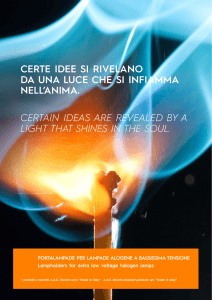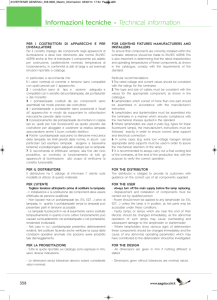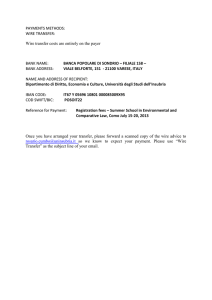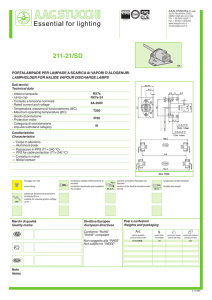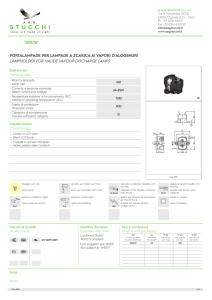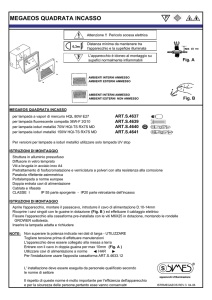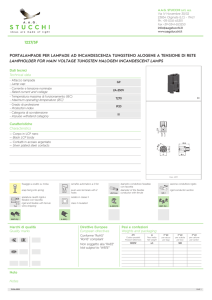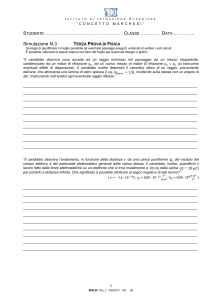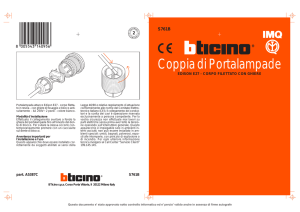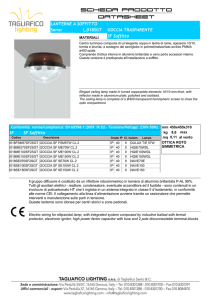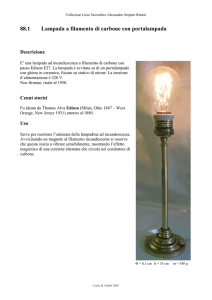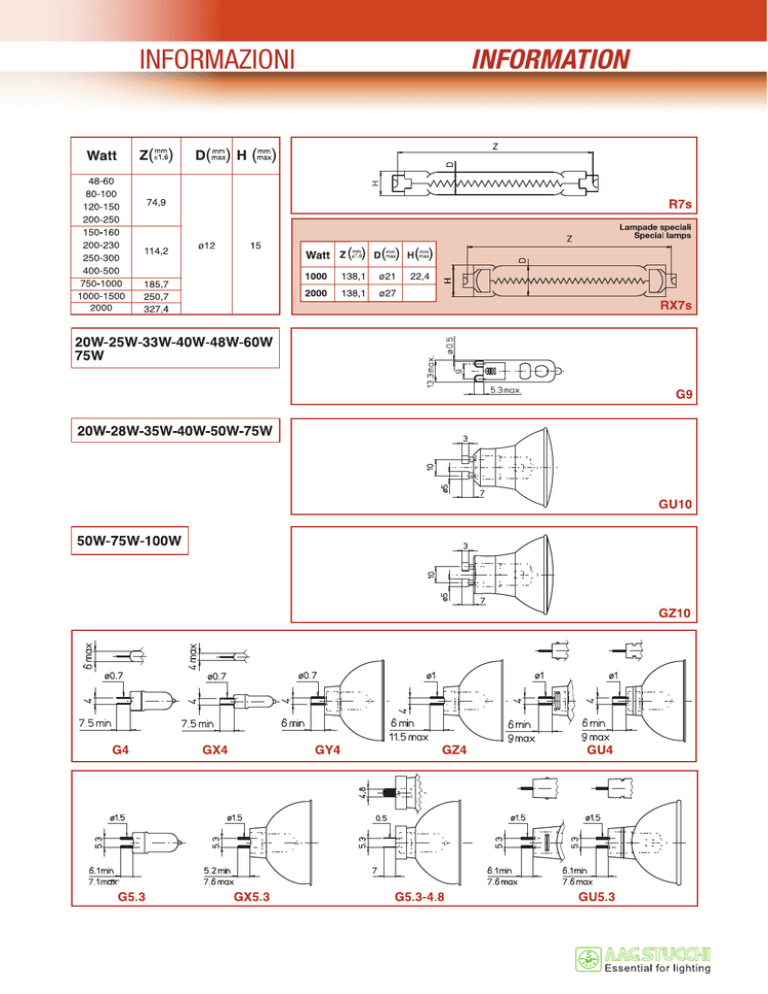
INFORMAZIONI
INFORMATION
INFORMATION
INFORMAZIONI
AVVERTENZE PER R7s - RX7s (tensione di rete)
WARNINGS FOR R7s - RX7s (main voltage)
I nostri portalampade sono costruiti per resistere alle alte
temperature prodotte dalle lampade (300 °C sulla parte
schiacciata, all'estremità del bulbo e 600 °C sulla parte
mediana del bulbo). Per questo motivo abbiamo utilizzato
materiali e cavi appropriati e curato la pressione di
contatto: nei portalampade per lampade R7s e RX7s,
l'elemento di contatto è realizzato in rame con punta in
argento. Molle di acciaio speciale garantiscono la
pressione appropriata.
Our lampholders are made to withstand the high
temperatures produced by the lamps (300 °C at the
pinched ends and 600 °C in the centre of the lamp).
For this purpose appropriate materials and wires have
been selected and the contact resistance reduced by the
use of copper contacts with silver tips.
Special steel springs control the contact pressure.
1 I nostri portalampade R7s e RX7s già montati sulle staffe
assicurano che la forza ottimale di contatto sia contenuta
nei valori minimo e massimo, previsti nel foglio 7005-53-3
delle norme EN/IEC 60061-2, quando vengono inseriti
appositi calibri di differenti lunghezze. Una forza di
contatto eccessiva causa sollecitazioni meccaniche che
possono rompere la lampada in prossimità degli attacchi,
mentre una forza insufficiente causa un falso contatto e
provoca surriscaldamenti pericolosi nel punto di attacco
lampada/portalampade.
1 For R7s and RX7s lampholders which are supplied
assembled on brackets, the contact pressure can be
guaranteed to be between the maximum and minimum
values stated on page 7005-53-3 of the EN/IEC 60061-2
standards, when the gauges of various lengths are
applied.
A too high pressure may lead to mechanical breakages of
the lamp, close to the lamp caps, whilst a too low pressure
may allow dangerous overheating.
2 Per garantire una pressione sufficiente dopo il
montaggio nell'apparecchio d'illuminazione, la staffa su
cui sono fissati i portalampade R7s eRX7s deve essere
sostenuta anche alle estremità quando è fissata con la
sola vite e sostegno centrale.
2 To guarantee a good contact pressure after mounting
into the luminaire, the bracket on which the R7s and RX7s
lampholders are mounted must be supported at the ends
when they are fixed only by means of the central screw
and support.
3 Il montaggio di una coppia di portalampade R7s e RX7s
(forniti senza staffa) in ogni caso deve rispettare le
indicazioni contenute nelle norme sopra indicata e
pertanto devono essere montati alla distanza "A" indicata
a catalogo.
3 The mounting of R7s or RX7s lampholders, supplied
without connecting brackets, should comply with the
distances laid down in the above mentioned standards,
and care should be taken to mount these at the
distance "A" as shown in the catalogue.
4 Gli apparecchi di illuminazione devono essere in grado
di smaltire il calore prodotto dalle lampade affinchè sui
portalampade e sui cavi non venga superata la
temperatura ad essi assegnata.
4 Luminaires must be capable of dissipating the heat
produced by
the lamps, such that the operating temperatures of the
lampholders and the connecting wires are not exceeded.
5 I nostri portalampade R7s e RX7s sono stati progettati e
realizzati per essere utilizzati esclusivamente con lampade
per illuminazione. Non sono idonei per l’utilizzo con
lampade speciali (fotografiche, cinematografiche etc.)
5 Our R7s and RX7s lampholders have been designed and
produced to be used with lamps for lighting only. They
cannot be used with special lamps (photographic lamps,
cinematographic lamps etc.).
N.B. La protezione dai contatti accidentali, così come le
distanze in aria e superficiali verso le parti attive sulla
parte posteriore del portalampade, devono essere
rispettate al momento del montaggio.
N.B. To protect from electric shock, the creepage and
clearance distances from live parts on the back of
lampholders and any metal frame, must be observed
when they are mounted in a luminaire.
.../210
Finitura stucco
Stucco finish
RIFLETTORI
REFLECTORS
1206-L/... - 1207-S/... - 1208-S/...
.../230
Martellatura grande
Large hammering
INFORMAZIONI
INFORMATION
AVVERTENZE PER GU10 - GZ10 (tensione di rete)
WARNINGS FOR GU10 - GZ10 (main voltage)
Se si utilizza il portalampade con attacco GZ10, che
accetta sia le lampade GZ10 che GU10, l'apparecchio di
illuminazione deve essere sempre studiato e dimensionato
termicamente per la lampada GZ10, che è quella che
sviluppa più calore nella parte posteriore.
Lampholders for GZ10 lamp caps can be used with both
GZ10 and GU10 lamp.
Any luminaire using GZ10 lamps must be designed to
withstand the higher temperatures projected to the rear of
this lamp.
AVVERTENZE PER ARTICOLI FISSATI CON VITI AUTOFILETTANTI
WARNING FOR ARTICLES WITH SELF-TAPPING SCREWS FIXING
Le viti autofilettanti utilizzate per il fissaggio dei
portalampade alla lamiera devono essere esclusivamente
del tipo per plastica.
All self-tapping screws used to fix the lampholders must
be suitable for plastic material only.
CARATTERISTICHE DEI CONTATTI
CHARACTERISTICS OF CONTACTS
La maggior parte dei nostri portalampade ha contatti in
nickel puro al quale vengono elettricamente saldati i cavetti
per garantire un collegamento sicuro ed una migliore
funzione dissipatrice del calore sui piolini della lampada.
Most of our lampholders have pure nickel contacts to
which wires are electrically welded. This guaranties a safe
connection and a better heat dissipation on the lamp pins.
SERRAFILO AUTOMATICO
PUSH WIRE TERMINALS
I cavetti inseriti nei serrafili automatici sono permanentemente
collegati al portalampade e non possono più essere sostituiti.
The wires inserted in push wires terminals, are permanently
connected to the lampholders and can not be replaced.
COLLEGAMENTO LAMPADE ALOGENE A BASSISSIMA TENSIONE
EXTRA LOW VOLTAGE HALOGEN LAMPS WIRING
Quando l'alimentazione delle lampade a bassissima
tensione è effettuata attraverso un trasformatore
elettronico, gli elettroni, a causa dell'alta frequenza, al
passaggio della corrente si dispongono verso la superficie
esterna del conduttore (“effetto pelle”) con un
conseguente aumento della resistenza e della relativa
caduta di tensione (in aggiunta a quella dovuta alla
lunghezza del conduttore stesso).
When feeding extra low voltage lamps by means of an
electronic transformer, the electrons, due to the high
frequency, arrange themselves on the exterior surface of
the conductor (”skin effect”) producing an increase in
resistance and relative voltage drop (this must be added
to the volts drop relative to the length of the conductor).
Per evitare che attorno ai cavetti si crei un campo
magnetico che produca dei radio-disturbi, essi devono
essere posizionati in parallelo o attorcigliati fra loro,
soprattutto se lunghi.
To avoid the creation of a magnetic field around the wires,
producing radio interference, the wires have to be placed
parallel or twisted together, especially if they are long.
Per ridurre la caduta di tensione e la relativa diminuzione
del flusso luminoso delle lampade dovute ai cavetti di
collegamento tra lampada e trasformatore (sia elettronico
che elettromagnetico), la loro lunghezza deve essere
tenuta la più corta possibile (2 m max) e la sezione minima
dei conduttori utilizzata deve essere di 1 mm2.
To reduce the voltage drop and the relative loss of
luminous flux of the lamps, the cable between lamp and
transformer (either electronic or magnetic), must be kept
as short as possible, 2 m max, and the minimum section
of the conductors must be 1 mm2.
AVVERTENZE PER G4 - G5.3 - G6.35 (bassissima tensione)
WARNINGS FOR G4 - G5.3 - G6.35 (extra low voltage)
1 Consultare il catalogo generale per la scelta dei
portalampade.
1 Consult the general catalogue to choose lampholders.
2 Ottenere la bassissima tensione con un trasformatore di
sicurezza.
2 Supply the extra low voltage via a safety isolating
transformer.
3 Non collegare in serie le lampade direttamente sulla rete
di distribuzione.
3 Do not connect lamps in series on the supply line.
4 Assicurarsi che i cavetti, che escono dal portalampade,
non siano in trazione e non presentino piegamenti onde
evitare una diminuzione della pressione tra i terminali ed i
piolini della lampada.
4 Ensure that the wiring from the lampholder is not under
stress and avoid bending so that pressure between the
lamp terminals and lamp pins is avoided.
5 Verificare che le spine della lampada non siano coperte
da materiale isolante (per maggior sicurezza, smerigliare).
5 Ensure that the lamp pins are not covered by insulating
materials (if necessary, use sandpaper to remove any
impurities).
INFORMAZIONI
INFORMATION
6 Proteggere il portalampade dalle polveri.
6 The lampholder should be protected from dust access.
7 Assicurarsi che il faretto sia in grado di smaltire il calore
prodotto dalla lampada e non superi la temperatura
prevista per il portalampade onde evitare di
compromettere l'integrità e il suo funzionamento.
7 Make sure that the luminaire is able to dissipate the heat
generated by the lamp adequately and does not exceed
the lampholder foreseen temperature in order to avoid to
compromise its integrity and its working.
N.B. Non sostituire una lampada a bassissima tensione
con un'altra avente i piolini di diametro inferiore (es.: non
passare da G5.3... a G4).
N.B. Do not replace an extra low voltage lamp with one
having smaller diameter pins (i.e. do not replace a G5.3
lamp with a G4).
AVVERTENZE PER GY4 (bassissima tensione)
WARNINGS FOR GY4 (extra low voltage)
Le norme EN/IEC 60061 consentono che i portalampade
adatti per le lampade con attacco G4 possano essere
utilizzati anche con le lampade con attacco GY4, fatte
salve le seguenti condizioni:
The EN/IEC 60061 standards allow the lampholders for
lamps with G4 cap to be used for the lamps with GY4 cap
too, taking in consideration the following conditions:
1 Che ci sia uno spazio libero intorno al portalampade in
modo da consentire il corretto inserimento della base
della lampada e del riflettore.
1 A free space is provided around the lampholder in such
a way to allow the correct insertion of the lamp base and
the reflector.
2 Che la parte frontale del portalampade sia piana.
2 The front part of the lampholder must be plane.
TEMPERATURE “T...” DEI PORTALAMPADE
“T...” TEMPERATURE OF LAMPHOLDERS
Secondo le norme EN/IEC 60838-1, la marchiatura “T...”
indica la massima temperatura di funzionamento
assegnata ai portalampade (misurata dove avviene il
contatto elettrico con l'attacco della lampada).
According to EN/IEC 60838-1 standards, “T...” marking
indicates the maximum working temperature of a
lampholder (measured in the area where there is the
electric contact with the lamp cap).
Le temperature:
T (assegnata al portalampade)
T1 (assegnata a parti del portalampade se è diversa da T)
T2 (assegnata ai cavetti)
The temperature ratings:
T (for the lampholder)
T1 (for the lampholder parts if it is different from T)
T2 (for the wires)
non devono mai essere superate.
must not be exceeded under any circumstances.
TEMPERATURA DEI CAVETTI
TEMPERATURE OF WIRES
I cavetti di collegamento sono rivestiti da una guaina,
spesso costruita con un materiale isolante più sensibile al
calore (e quindi meno resistente) rispetto ad altri
componenti collocati all’interno dell’apparecchio di
illuminazione
The insulation material of the wires is often sensitive to
temperature and normally has a lower operating
temperature than the other components in the fitting.
Pertanto l’apparecchio non deve sviluppare una
temperatura superiore a quella assegnata ai cavetti.
For this reason the internal temperature of the luminaries
must not exceed that assigned to the wires.
ESTREMITA’ DEI CAVETTI FLESSIBILI
FLEXIBLE WIRES END
Gli articoli con cavetti flessibili spelati 8 mm e fascetta
sulle estremità possono essere forniti anche nelle seguenti
versioni a richiesta:
Articles with 8 mm stripped wires and brass ferrule on the
lead wires end can be supplied also in the following on
demand versions:
- ...-LE: solo con spelatura 8 mm
- ...-TE: con spelatura 8 mm e con isolante inciso
- ...-LE: only with 8 mm stripping
- ...-TE: with 8 mm stripping and notched insulation
N.B. L’isolante lasciato sui conduttori potrebbe risultare
mancante al ricevimento della merce a causa dei
movimenti impropri subiti durante la produzione e le
operazioni di trasporto.
N.B. Due to shocks during production and delivery
operations, the insulation left on the conductors could be
missing at the goods receiving.
Versione standard
Standard version
Versioni a richiesta
Versions on demand
INFORMATION
INFORMAZIONI
CATEGORIA DI SOVRATENSIONE
IMPULSE WITHSTAND CATEGORY
I portalampade per lampade alogene (EN/IEC 60838-1)
sono conformi alle distanze in aria e superficiali richieste
per la categoria di sovratensione II (norme EN/IEC 60664-1).
Lampholders for halogen lamps (EN/IEC 60838-1) are in
accordance with the prescribed creepage distances and
clearances for the impulse withstand category II (EN/IEC
60664-1 standards).
COLLAUDO FINALE DEGLI APPARECCHI DI ILLUMINAZIONE
LUMINAIRES FINAL TEST
La scelta dei componenti e il loro corretto montaggio
compete al costruttore dell’apparecchio di illuminazione
che deve anche provvedere al suo collaudo finale per
verificarne il buon funzionamento.
The luminaire manufacturer is responsible for the choice
and the correct mounting of the components and he must
also carry out a final test on the luminaire to verify its
correct operation.
CAVETTI
WIRES
Conduttore rigido in Cu stagnato - Cavetto in SILICONE 180 °C
Rigid conductor in Cu tinned - Wire in SILICONE 180 °C
Conduttore rigido in Cu nichelato - Cavetto in PTFE 250 °C
Rigid conductor in Cu nickel plated - Wire in PTFE 250 °C
Conduttore flessibile in Cu - Cavetto in SILICONE 180 °C
Flexible conductor in Cu - Wire in SILICONE 180 °C
Conduttore flessibile in Cu stagnato - Cavetto in SILICONE 180 °C - Estremità con fascetta
Flexible conductor in Cu tinned - Wire in SILICONE 180 °C - Ferrule on lead wire end
Conduttore flessibile in Cu nichelato - Cavetto in PTFE 250 °C - Estremità con fascetta
Flexible conductor in Cu nickel plated - Wire in PTFE 250 °C - Ferrule on lead wire end
Conduttore flessibile in Cu stagnato - Cavetto in FEP 180 °C - Estremità con fascetta
Flexible conductor in Cu tinned - Wire in FEP 180 °C - Ferrule on lead wire end
Conduttore flessibile in Cu - Cavetto in NPV 180 °C
Flexible conductor in Cu - Wire in NPV 180 °C
Conduttore flessibile in Cu - Cavetto in SILICONE 180 °C con calza di vetro - Estremità con fascetta
Flexible conductor in Cu - Wire in SILICONE 180 °C with glassbraid - Ferrule on lead wire end
Conduttore flessibile in Cu stagnato - Cavetto in SILICONE 180 °C - Doppio isolamento - Estremità con fascetta
Flexible conductor in Cu tinned - Wire in SILICONE 180 °C - Double insulation - Ferrule on lead wire end
Conduttore flessibile in Cu nichelato - Cavetto in PTFE+PTFE 250 °C - Doppio isolamento - Estremità con fascetta
Flexible conductor in Cu nickel plated - Wire in PTFE+PTFE 250 °C - Double insulation - Ferrule on lead wire end

